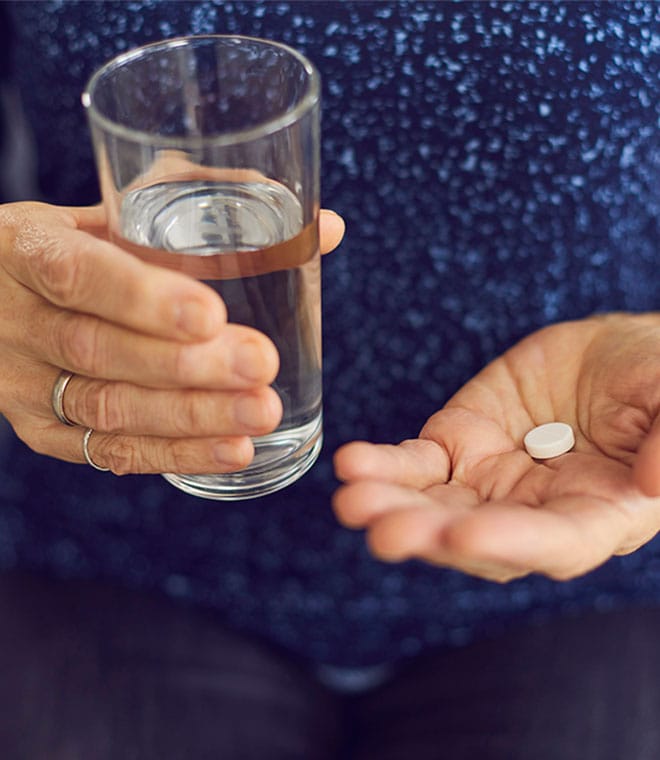Health
What causes medication shortages?
By Lauren Viera Feb 21, 2023 • 14 min
For five years, Chelsea Johnson has suffered from type 2 diabetes caused by polycystic ovary syndrome (PCOS). During that time, she’s kept it under control by maintaining a healthy lifestyle and managing a variety of prescriptions, including Ozempic, a five-year-old injectable prescription medication whose active ingredient, semaglutide, helps regulate blood sugar levels.
Ozempic was a game changer for Johnson. Since she began taking it in 2018, she was able to keep her blood sugar levels below what’s considered normal for people without diabetes, and she dropped most of the weight brought on by her PCOS. It helped that she could easily afford the medication. After insurance, Ozempic only cost her $5 each month. The medication made such a difference that she recommended it to both her parents, who also have diabetes.
But a few months ago, the Chicago-based Johnsons got some startling news from their family doctor — an Ozempic shortage was predicted to affect the city by the end of the year, and access to the medication would become nearly impossible.
As it turns out, the same medication that people like the Johnsons use to keep their diabetes in check was trending on TikTok. It's been embraced by celebrities and a growing number of diet fanatics desperate for the next hot weight loss trend.
Trends pass, but medication shortages persist
The good news? Before long, Ozempic’s reputation as a “miracle” drug for weight loss will fade, and eventually Johnson, her parents and others will be able to reliably fill the prescriptions they need. (In fact, along the Eastern Seaboard, Ozempic has already been eclipsed by Mounjaro, another injectable drug prescribed for type 2 diabetes that causes weight loss like Ozempic.)
But even when the hype surrounding the latest drug trend has died down, national medication shortages remain — and not just those tied to weight loss. Current shortages run the gamut from prescriptions that combat pediatric respiratory viruses to mental health aids, due to causes far more complex than a trending hashtag.
Though 2023 medication shortage levels aren’t nearly as high as they were a decade ago, a surprising number of drugs remain difficult to obtain. As of February 2023, there are 234 medications on the American Society of Health-System Pharmacists’ drug shortage database, an increase since fall 2022. And because pharmaceutical companies market the same drugs under different brand names, those shortages impact hundreds of prescriptions. Semaglutide, for example, the blood-sugar regulating drug that’s been on the shortage list since early 2022, is used in product variations of Ozempic and Wegovy, another branded semaglutide product approved for weight loss.
It poses major challenges for any patient, but it’s especially onerous when considering the entrenched healthcare inequities in underserved communities across the country. When Ozempic isn’t available at a go-to pharmacy, patients are often encouraged to try alternate pharmacies before resorting to changing prescriptions. As a stop-gap measure, it’s inconvenient for some, but impossible for others.
“Me and my family have the ability to jump in the car and try to track down meds,” Johnson says. “But folks who are unfortunately stuck in their neighborhoods or only have that one pharmacy or hospital nearby, they aren't able to find these medications for their families."
Adding to that concern, underserved communities are more likely to be impacted by the related socio-economic effects. According to a study on drug shortages published by the Public Library of Science in 2019, when shortages weren’t as acute as they are now, patients were more commonly reported to have “increased out-of-pocket costs, rates of medication errors, adverse events, mortality and complaints” during the time of shortage.
So what’s causing shortages? It’s complicated
The trickiest thing about medication shortages is that there’s no simple explanation for why they happen. As logical as it may seem to blame current medication shortages on something like post-pandemic supply chains, that’s only one slice of the pie. Demand clearly plays a huge role in classified drug shortages as well. And, as with any federally regulated product, the rules are a third major cause of drug shortages according to a 2021 study by Frontiers in Pharmacology.
Additional factors include drug fads (as is the case with Ozempic), manufacturing issues and other industry-controlled factors, such as raw materials. And causes can vary drastically from year to year. For example, 2012 was a record-setting year for medication shortages that were eventually determined by the Frontiers study to be rooted primarily in quality-control delays, manufacturing and discontinuation. By comparison, the primary reason for medication shortages in 2020 was recorded by the same study to be “unknown.”
What’s more, the basic drivers of any industry — the textbook supply-and-demand model — don’t apply to pharmaceuticals. That’s because medication shortages can’t be readily resolved by a market response. Typically, a sudden increase in demand (caused by, say, a TikTok weight loss trend favoring Ozempic) motivates a manufacturer’s response to increase its supply. But drug manufacturing operates on a totally different timeline.
Even if a manufacturer is aware of an increase in demand, and even if there’s an opportunity to ramp up supply, it’s unlikely to trickle down to the consumer supply chain fast enough to relieve a local shortage.
Patients must make difficult decisions
Meanwhile, long-term Adderall prescriptions are having to compete with an uptick in new demand. For 27-year-old Maggie O’Brien, who has taken Adderall for five years to address her ADHD, there was no warning when her prescription ran out last October. Fulfilling her prescriptions via the Capsule app, O’Brien was served a generic message along the lines of, “Your prescription cannot be filled. Please call your doctor.” Only after Googling around and learning about the Adderall shortage did O’Brien realize what she might be up against.
“I tried a few pharmacies, but no one had it,” O’Brien says. “I work retail, so on my days off, I was sitting and waiting on hold with all of these pharmacies only to be told, ‘No, we don’t have it, and we don’t know when we’ll have it again.’” After two weeks with no prescription, O’Brien eventually got a tip about a specific grocery store pharmacy that might have Adderall in stock. She successfully moved her prescription and was able to refill her 30-day supply. But then, she was out again.
“What’s so silly and cruel is that even before the shortage, because Adderall is a controlled substance, it’s already annoying to try to transfer it to a new pharmacy,” O’Brien says. “You have to have your doctor do it every single time; you can’t do it on your own. So being bounced around from pharmacy to pharmacy only to be on hold for 20 minutes, I just felt very bummed about it and very stressed.”
“During the pandemic, because of COVID-19, we saw the rise of telehealth and a lot of patients being seen through telehealth getting prescriptions for Adderall,” says Donovan Tran, Walgreens Healthcare Supervisor for the Los Angeles area. Tran said he’s seen a lot of prescriptions coming from increased telehealth visits compared to in-person, mirroring a national trend.
Lauren Jankowski, 38, went through a similar Adderall scavenger hunt across Chicago's western suburbs just before the holidays. Diagnosed with ADHD in middle school, she has relied on the medication for more than 20 years to help her focus in her daily life and work. When she heard news of the shortage last fall, her anxiety spiked.
“I was down to my last pill when we finally got the prescription filled after calling four places,” she says. “It was like, if I can’t get this med, I’m going to lose my god-dang job. Sometimes with Adderall, if there’s a shortage or an issue getting it, people brush it aside — and that’s a horrible way of thinking. They might think, ‘Your life isn't at risk,’ like it’s almost a frivolous medicine. You don’t know what it’s like to live with 50,000 browser windows open in your head at all times.”
When demand exceeds supply, pharmacists get strategic
Though both O’Brien and Jankowski were eventually able to fill their prescriptions, sometimes there simply isn’t any supply available to fill. So what’s a pharmacy to do when it can’t provide what a patient needs? Answer: It gets strategic.
The first step is to increase communication between the pharmacy and the prescribing doctor, says Tran, so that alternatives can be explored when possible. “That touch point between the doctor and the pharmacy is more important than ever,” he says. “If [patients] can’t get medicine and there’s not a way to use another strength, they’ll have to call the doctor to switch it to something else that may be in the same class of drug, or similar.”
Writing alternative prescriptions was a topic at a recent summit on medication shortages with pharmacy managers in Houston, where La Vonia Cannon oversees Walgreens pharmacies. “We reiterated that [pharmacists] should be keeping their providers informed [on drug shortages] to ensure our patients can get the medicines they need as quickly as possible,” she says, emphasizing that being transparent with providers and patients is critical.
In some instances, a medication is available, but the dosage is not. During an especially brutal cold and flu season, made worse by a rise of respiratory syncytial virus (RSV), an ongoing shortage of Tamiflu and amoxicillin forced pharmacists to return to their roots of compounding drugs.
Compounding drugs from scratch allows pharmacists to tailor a dosage to a patient on a case-by-case basis. Miranda Cobbs, Walgreens healthcare supervisor for Virginia and Washington, D.C., says that when her pharmacies weren’t auto-replenished with Tamiflu this season, they resorted to compounding to serve the youngest patients that aren’t yet ready to swallow pills. Compounding is an old school solution to an ongoing problem. But it’s time-consuming and difficult — not ideal for pharmacies that are already short-staffed.
Going the extra mile — literally
Cobbs admits this winter’s cold and flu season “feels different than any other year” in terms of experiencing shortages of medications used to fight viruses. But she’s not discouraged. “This is not the first time we’ve had a drug shortage, and it won’t be the last,” she says. Years ago, during a shortage of a blood pressure drug called Atenolol, Cobbs recalls using her Walgreens connections to help re-up her home pharmacy. Having occasionally picked up shifts at a rural Walgreens near her grandmother’s home some 2 1/2 hours away, Cobbs was able to call in a favor when her home pharmacy ran out of Atenolol.
“It’s in our DNA to take care of our patients first,” Cobbs says. To retrieve the highly sought-after supply of Atenolol from the sticks, she drove 2 1/2 hours one way and 2 1/2 hours back and didn’t get home until 11 o’clock that night. “But that’s what we do.”
Published February 2023.
Sources:
- https://www.drugs.com/history/ozempic.html
- https://www.theguardian.com/australia-news/2022/may/31/shortage-of-diabetes-medication-ozempic-after-tiktok-users-promote-drug-for-weight-loss
- https://www.rollingstone.com/culture/culture-features/ozempic-wegovy-tiktok-miracle-weight-loss-1234642896/
- https://www.ashp.org/drug-shortages/shortage-resources/drug-shortages-statistics?loginreturnUrl=SSOCheckOnly
- https://www.ashp.org/drug-shortages/current-shortages/drug-shortages-list?page=CurrentShortages&loginreturnUrl=SSOCheckOnly
- https://www.ashp.org/drug-shortages/current-shortages/drug-shortage-detail.aspx?id=813&loginreturnUrl=SSOCheckOnly
- https://journals.plos.org/plosone/article?id=10.1371/journal.pone.0215837
- https://www.frontiersin.org/articles/10.3389/fphar.2021.693426/full
- https://www.fda.gov/media/131130/download
- https://www.theguardian.com/us-news/2023/jan/07/adderall-shortage-increased-demand-telehealth-startups




